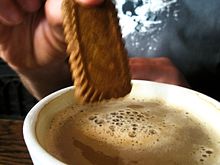- Dunking (biscuit)
-
To dunk is to dip a biscuit (or cookie), bread, buttered toast, cake, or doughnut into a beverage, especially tea, coffee, or cold milk. Dunking releases more flavour from confections by dissolving the sugars,[1] while also softening their texture. Dunking can be used to melt chocolate on biscuits to create new rich flavours not tasted before.
Dunking is a popular way of enjoying biscuits in many countries, in particular, the UK. A popular form of dunking in Australia is the "Tim Tam Slam", also known as 'tea sucking'. The physics of dunking is driven by the porosity of the biscuit and the surface tension of the beverage. A biscuit is porous and, when dunked, capillary action draws the liquid into the interstices between the crumbs.[citation needed]
The most popular biscuit to dunk in the UK is the chocolate digestive,[2] although it is unclear whether this refers to milk or dark chocolate, or both.
In South Africa, rusks are a popular food for dunking in both tea and coffee.
Dunking is also used as a slang term for intinction: the Eucharistic practice of partly dipping the consecrated bread, or host, into the consecrated wine, by the officiant before distributing.
Contents
Biscuit dunking and etiquette
Different cultures have different attitudes to biscuit dunking. In British high society, dunking has traditionally been frowned upon in public, but widely practiced in private.[citation needed] The etiquette of non-dunking has spread to tea-rooms throughout Britain.[3][4]
Biscuit dunking and science
Physicist Len Fisher of the University of Bristol presented some light-hearted discussion of dunking on "National Biscuit Dunking Day", as part of an attempt to make physics accessible. Fisher appeared to be somewhat taken aback by the large amount of media attention, ascribing it to a "hunger for accessible science". Fisher also described his astonishment at journalists' interest in one equation used in the field: Washburn's equation, which describes capillary flow in porous materials. Writing in Nature, he says "the equation was published in almost every major UK newspaper. The journalists who published it took great care to get it right, some telephoning several times to check".[5][6]
Dunk, Nibble, Rotate technique
Sometimes, a biscuit may be slightly wider than the cup of tea of coffee into which it is intended to be dunked. A common method of overcoming this problem is to dunk the edge of the biscuit into the hot beverage, then nibble the part of the biscuit that was submerged. It should now be possible to rotate the biscuit in such a way that it can be dunked wholly.
Erosion technique
Inevitably, some biscuits have a diameter that exceeds that of the rim of a tankard. An alternative to the technique above is the erosion technique. This consists of scraping the edge of the biscuit on the rim to erode the biscuit and therefore diminish its diameter to allow comfortable passage into the beverage below. A bonus to this technique is the residue left by the erosion of the biscuit. This is often nutritious and packs extra taste due to its spending a sizeable amount of time being saturated at the base of the mug.
Cultural references
In Marcel Proust's novel In Search of Lost Time one of the narrator's childhood memories sets in while tasting a madeleine dunked in tea. The soft, spongy consistency of the madeleine could seem like an odd choice as dunking is more common with crisp baked products, such as biscuits. In fact, draft versions of Proust's manuscript reveal that the author initially had the narrator dunk a piece of toasted bread.[7]
See also
References
- ^ Lee, Laura. The Pocket Encyclopedia of Aggravation. New York: Black Dog & Leventhal, 2001.
- ^ http://www.telegraph.co.uk/foodanddrink/foodanddrinknews/4927255/Chocolate-digestive-is-nations-favourite-dunking-biscuit.html
- ^ http://www.telegraph.co.uk/news/uknews/1559761/Tea-room-outlaws-biscuit-dunking.html
- ^ http://www.timesonline.co.uk/tol/life_and_style/food_and_drink/article2217991.ece
- ^ quotes from Nature 397, 469; 1999)
- ^ http://www.independent.co.uk/news/biscuit-dunking-perfected-1187126.html
- ^ http://www.arte.tv/fr/connaissance-decouverte/karambolage/Cette-semaine/Emission-du-13-Juillet-2008/2106110,CmC=2107242.html
Categories:- Biscuits (British style)
- Food culture
Wikimedia Foundation. 2010.

